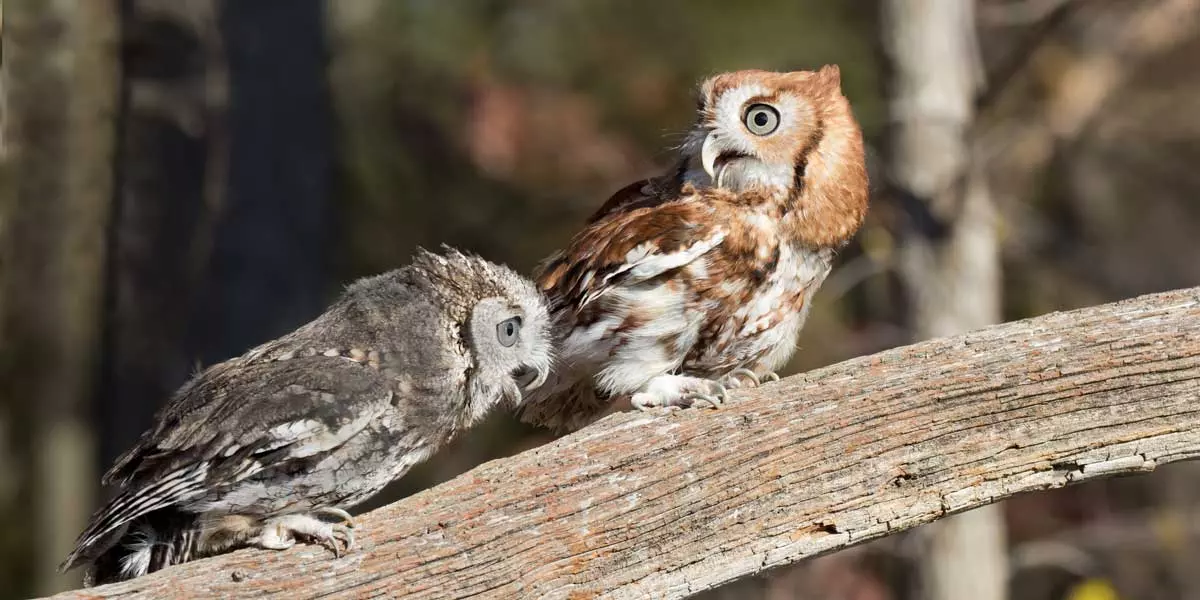FREQUENTLY ASKED QUESTIONS
#1 What exactly is this wooden box?
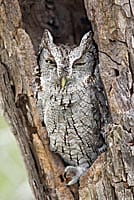
Image courtesy of: Greg Lasley
This Owl Shack resembles a tree hollow or cavity. Some birds, like screech owls, roost and nest in tree hollows or cavities. Since screech owls are not able to excavate a hole like a woodpecker can, they must rely on finding a naturally rotten hollow or an abandoned woodpecker cavity. These are typically found in dead wood. In urban environments, however, humans remove most dead wood since it could fall on our homes or automobiles. Owl Shacks provide screech owls with a much-needed home for roosting or nesting. These Owl Shacks work well in urban environments, even on a tiny property.
#2 What is a screech owl?
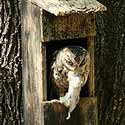
Image courtesy of: Eric Hull
Over 20 species of owls have been documented in the U.S. Screech owls are some of the smaller members of the family and are about the length of a cardinal (but much huskier). They eat large insects like moths, grasshoppers, and roaches or small rodents like mice, so they are quite beneficial to humans. They do not catch or kill anything larger than they can handle, and they are not fierce predators so they have no interest in attacking humans, dogs, or cats.
#3 Can I provide screech owls with food?
Since screech owls are wild animals, don’t worry about feeding them as if they were domesticated pets. They will forage freely on their own. Instead, simply provide and maintain plenty of natural green space.
#4 Where do screech owls live?
There are two widespread species of screech owls in the U.S., the Eastern and Western Screech-Owls, plus a third species, Whiskered Screech-Owl, which is found in the mountains of southeast Arizona and points farther south. When combined, their ranges blanket the continental U.S. plus parts of Alaska, Canada, and Mexico. Screech owls prefer areas where woods meet openings. The woods provide roosting habitat while the openings provide foraging habitat. A large, treeless grassland will not suffice, nor will an extensive, dense forest. Urban habitats are heavily used by screech owls since our shaded lawns, parks, and golf courses often provide adequate habitat.
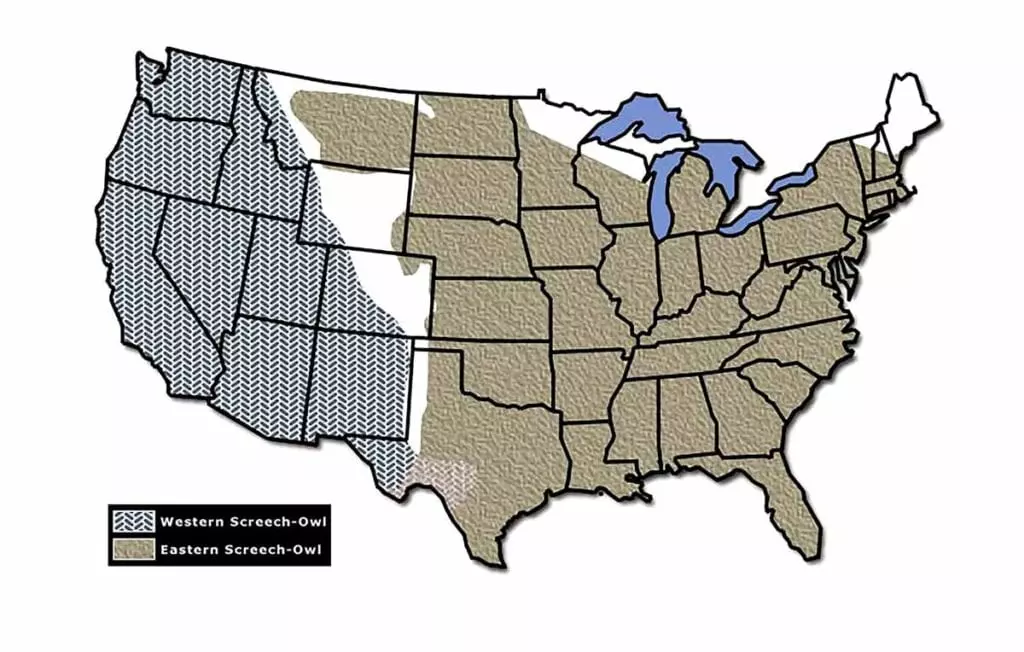
#5 Where should I place my owl house?
Placement of your Owl Shack is important. Attach two of the three brackets to a vertical tree limb with a total of four heavy nails or wood screws. The rooftop needs to be 10 feet above the ground or higher. Face the Owl Shack in any direction except to the north where cold winter breezes are not welcome. Select a more open side of the tree so the owls can come and go without trying to fly through branches and leaves. If possible, position the Owl Shack on the main trunk under a large horizontal or diagonal limb to help keep rainwater off the Owl Shack. Mount the Owl Shack on a hardwood tree (oak, hickory, pecan, etc.) or a pine tree. Don’t place the Owl Shack in a thicket or in dense vegetation like cedars, junipers, or shrubbery. The owls might not find it or they might not be able to maneuver well when flying in or out. Allow them a clear flight path.
Make sure the Owl Shack is level, or nearly so, to allow the roof to keep out rainwater or bright sun. Several drain holes have been drilled in the floor in case of heavy rain. A slight tilt of the Owl Shack downward or frontward is acceptable, but a slight tilt upward or backward is not recommended. Most importantly, place the Owl Shack where you can enjoy it from a home window, but at a comfortable distance for the owls (about 20 feet or greater).
#6 Do I need to put anything in the bottom of my owl house?
Yes. Simply grab a heaping handful or two of dry leaf litter from your property and place it inside the Owl Shack. A very small proportion can be made up of old dry grass clippings, thin brittle sticks, and the like. Do not include any green vegetation or anything that’s been freshly cut. And you’ll only need to do this once every few years. Insure that the handful does not include soil or anything wet or green as this may accelerate wood rot to the floor of your Owl Shack. Never use sawdust or woodchips as they might harbor mites more than the leaf litter will.
#7 What other critters might use my owl house?
Other species, such as squirrels, half-grown opossums, or wasps would enjoy making a home in this Owl Shack. If you see sticks or leaves hanging out, then your Owl Shack is probably occupied by a mammal that has collected nest material. Screech owls typically do not do this. If your tenant is something other than an owl, it is best to simply mount another Owl Shack in an attempt to please all the area residents. The large entrance hole is typically not desirable to most of our cavity-nesting birds like starlings, bluebirds, titmice, or chickadees. It is possible, however, that a female wood duck might try to lay eggs in and incubate her clutch if your Owl Shack is placed near permanent water.
#8 What are these owl houses made of and how long will they last?
This Owl Shack is made of cedar and, if handled gently, should last for years. The Owl Shack is already painted and is ready to be mounted. It should require no cleaning or maintenance, inside or out.
#9 When will an owl find this owl house and what should I do when it happens?
Screech owls typically use these Owl Shacks as a roost during cooler weather or when breeding. The Owl Shack gets very hot during the summer, especially in the South, so screech owls might roost out on a limb where it’s cooler.
Occupancy might be immediate or it may take a couple of years (or maybe never at all, especially if the owls in your area already have a favorite hollow). Amazingly, several landlords had their first owl tenant just one day after mounting their Owl Shack while others have taken years! With luck, your Owl Shack could become occupied by an owl soon. If so, enjoy watching as the bird will often snooze or stretch in the entrance hole. If an owl is startled or disturbed while sitting in the entrance hole, it will typically retreat down to the bottom of the Owl Shack, especially when scolded and mobbed by jays, titmice, and other songbirds. Trimming or pruning limbs within close proximity of an occupied Owl Shack could disturb your owl tenant. As crazy as it sounds, consider doing any pruning after dusk with a flashlight once your owl has departed for the night to forage. Otherwise, wait until the dead-of-summer when owls are not using the Owl Shack at all. These tips could help you from permanently frightening away your owl.
#10 Since owls are active at night, how will I know they are around?
Screech owls frequently call throughout the night. Their name is not very accurate since they typically do not emit any “screeching” noises. Instead, adults give a long, trilling whistle that is sometimes reminiscent of a horse’s whinny. Most owls are nocturnal, but screech owls will often sit and snooze in the entrance hole of this Owl Shack for long periods mostly during twilight hours.
#11 Do screech owls bother my backyard bird feeders or songbirds (including my Purple Martin house)?
Screech owls are probably already in your area and have been long before we settled this nation. Thus your songbirds have lived in harmony with these owls for centuries. You won’t be attracting an owl from afar; instead you will finally be able to see exactly where your area owl roosts. Screech owls do not forage during daylight hours (too bright) when your bird feeder is most active with songbirds. By night, that same bird feeder is probably active with rodents and roaches feasting on leftover birdseed. These are some of the very things that screech owls devour!
#12 I've heard that Great Horned Owls eat screech owls and the horned owl occurs in my area. Will my screech owl end up in the belly of the much larger horned owl?
The Great Horned Owl and Eastern Screech-Owl, for example, occur together in about 40 U.S. states. They have lived in harmony for millenia. The much larger horned owl, like most predators, is opportunistic and will eat almost any animal flesh that they can capture. Actually, you might be helping your local screech owls by providing them with this safe place where a large owl could never get them. Without this owl house (or an abandoned woodpecker cavity), your screech owl could be out in the open more and thus exposed to potential predators.
#13 Will kids or dogs running and playing loudly near my owl house keep an owl from taking up residency? And what about my tree-climbing pet cat?
Typical backyard activities and loud noises likely will not keep an owl from roosting in your owl house. One landlord, for example, mentioned how his kids and dog run wild directly under the owl house while the owl comfortably snoozes in the owl house’s entrance. And this particular landlord stated that he can even rake leaves in fall directly under the owl house without disturbing the bird. This owl house is deep enough that a mature cat could not enter or paw around inside after the owl safely retreats to the bottom.
#14 What is the maximum number of owl houses I can put up on my property?
The average urban or suburban property of one acre or less can support a maximum of 2 owl houses. On a larger scale, the average urban or suburban neighborhood can support one pair of owls for every 1 to 2 square city blocks (depending on several factors like habitat quality). So the owls on your property also occupy your next door neighbor’s property. A larger property can easily support 2 or 3 owl houses for every 5-20 acres (depending on habitat quality). A large ranch, for example, will have multiple pairs of screech owls on the property so consider mounting a pair of owl houses for every 5-20 acres of screech owl habitat (depending on location, habitat quality, etc.).
#15 I bought two owl houses and would like to know how far apart to mount them.
The only recommendation is not to mount them in the same tree. Select two different trees with trunks that are at least ten feet apart. The two owl houses can face one another, or not; this is not essential. And remember to follow all of the other mounting guidelines with each owl house (e.g., height, direction).
#16 How can we tell the male screech owl from the female?
The sexes appear identical in markings and coloration. The female, however, is 10-15% larger than her mate but it is often difficult to judge size unless the two are sitting side by side. Sometimes the owl house entrance can be used as a reference for “sizing up” the bird but often times there are just too many factors involved that can change the bird’s length and width (i.e., puffing up when chilled or the opposite when warm, stretching tall and/or erecting the ear tufts when approached). So if you’re trying to decide on a worthy name for your owl, it might be best to consider giving it a unisex name. A list of names already taken appears on the Naming Your Owl page at owlshack.com.
#17 Since there are different colored Eastern Screech-Owls out there, will my backyard owl change color with age or season?
No. Screech owls are the same color for life; individuals do not change colors. There are two color morphs of Eastern Screech-Owls: gray and rufous (“reddish”). Some ornithological references, however, acknowledge a third and noticeably different color morph of brown. Both gray and rufous morphs can occur together but in different proportions depending on geographic location. In the western part of the bird’s range (i.e., Central Texas, Great Plains) screech owls tend to be more gray morphs, while those in the southeastern part of their U.S. range (i.e., East Texas Pineywoods east to the Atlantic Coast) tend to be more rufous morphs. One leading reference that only acknowledges the two color morphs reports that 36% of Eastern Screech-Owls rangewide are rufous (thus the rest are gray). A “mixed” breeding pair of gray and rufous morphs is not unusual. And a breeding pair of one morph can produce offspring of the other morph.
#18 Our backyard does not appear to have an adequate tree to mount the owl house. Are we out of luck?
Owl houses also work well when mounted high to the side of a house, garage, or the like. A metal pole is also a great idea. Select an area that is shaded for at least half of daylight hours. An opening or field will make the dark owl house and all of its contents bake in the sun. Remember to read Question #5 above for important tips before getting started. Before the pole goes up, pre-drill your holes in the pipe to the brackets on the top and bottom of the owl house (ignore the third bracket on the side). Don’t mount the owl house yet. Set the pole level in a small amount of cement that will serve as a steady underground anchor. Let the cement dry before mounting the owl house. A metal flashing “predator guard” is also recommended since rat snakes spend about 75% of their lives above ground in search of birds, eggs, and nestlings. Without much trouble, they can wrap around and climb a slick metal pole.
#19 When will an owl find this owl house and what should I do when it happens?
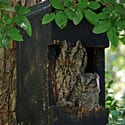
An adult screech owl is on the left while an approximately 25-day-old nestling is on the right. This photo was snapped by John Ferguson.
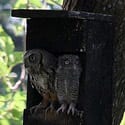
An adult screech owl is on the left while an approximately 25-day-old nestling is on the right. This rare pose was snapped by Amy Rose.
#20 How do screech owls get up and down the inside of the owl house?
#21 I'm curious about the dark paint job to the exterior of your owl houses.
#22 A nestling owl has fallen out of its nest. What should we do?
#23 Once my owl house becomes occupied, who should I tell?
Tell everyone, but it would be great to email a photo and a brief story of your new owl tenant to the owl house designer and builder at cliffordshackelford@gmail.com so that your experience can be shared with others.
Check out Owl Shack on FACEBOOK
